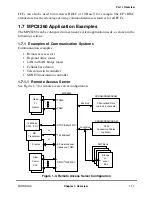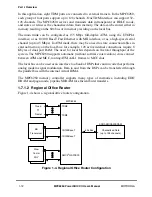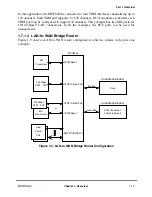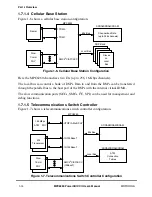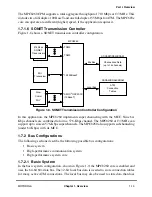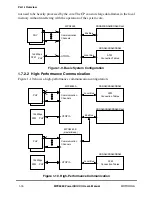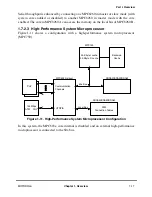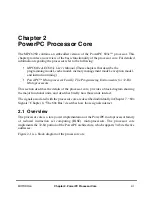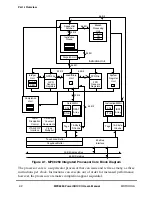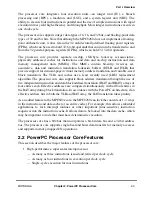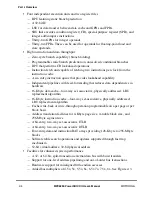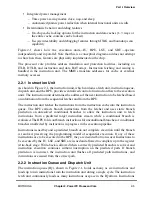
MOTOROLA
Chapter 2. PowerPC Processor Core
2-7
Part I. Overview
2.2.4.2 Load/Store Unit (LSU)
The LSU executes all load and store instructions and provides the data transfer interface
between the GPRs, FPRs, and the cache/memory subsystem. The LSU calculates effective
addresses, performs data alignment, and provides sequencing for load/store string and
multiple instructions.
Load and store instructions are issued and translated in program order; however, the actual
memory accesses can occur out of order. Synchronizing instructions are provided to
enforce strict ordering where needed.
Cacheable loads, when free of data dependencies, execute in an out-of-order manner with
a maximum throughput of one per cycle and a two-cycle total latency. Data returned from
the cache is held in a rename register until the completion logic commits the value to a GPR
or FPR. Store operations do not occur until a predicted branch is resolved. They remain in
the store queue until the completion logic signals that the store operation is deÞnitely to be
completed to memory.
The processor core executes store instructions with a maximum throughput of one per cycle
and a three-cycle total latency. The time required to perform the actual load or store
operation varies depending on whether the operation involves the cache, system memory,
or an I/O device.
2.2.4.3 System Register Unit (SRU)
The SRU executes various system-level instructions, including condition register logical
operations and move to/from special-purpose register instructions, and also executes
integer add/compare instructions. Because SRU instructions affect modes of processor
operation, most SRU instructions are completion-serialized. That is, the instruction is held
for execution in the SRU until all prior instructions issued have completed. Results from
completion-serialized instructions executed by the SRU are not available or forwarded for
subsequent instructions until the instruction completes.
2.2.5 Completion Unit
The completion unit tracks instructions from dispatch through execution, and then retires,
or completes them in program order. Completing an instruction commits the processor core
to any architectural register changes caused by that instruction. In-order completion ensures
the correct architectural state when the processor core must recover from a mispredicted
branch or any exception.
Instruction state and other information required for completion is kept in a Þrst-in-Þrst-out
(FIFO) queue of Þve completion buffers. A single completion buffer is allocated for each
instruction once it enters the dispatch unit. An available completion buffer is a required
resource for instruction dispatch; if no completion buffers are available, instruction
dispatch stalls. A maximum of two instructions per cycle are completed in order from the
queue.
Summary of Contents for MPC8260 PowerQUICC II
Page 1: ...MPC8260UM D 4 1999 Rev 0 MPC8260 PowerQUICC II UserÕs Manual ª ª ...
Page 66: ...lxvi MPC8260 PowerQUICC II UserÕs Manual MOTOROLA ...
Page 88: ...1 18 MPC8260 PowerQUICC II UserÕs Manual MOTOROLA Part I Overview ...
Page 120: ...2 32 MPC8260 PowerQUICC II UserÕs Manual MOTOROLA Part I Overview ...
Page 138: ...Part II iv MPC8260 PowerQUICC II UserÕs Manual MOTOROLA Part II Configuration and Reset ...
Page 184: ...4 46 MPC8260 PowerQUICC II UserÕs Manual MOTOROLA Part II ConÞguration and Reset ...
Page 202: ...Part III vi MPC8260 PowerQUICC II UserÕs Manual MOTOROLA Part III The Hardware Interface ...
Page 266: ...8 34 MPC8260 PowerQUICC II UserÕs Manual MOTOROLA Part III The Hardware Interface ...
Page 382: ...10 106 MPC8260 PowerQUICC II UserÕs Manual MOTOROLA Part III The Hardware Interface ...
Page 392: ...11 10 MPC8260 PowerQUICC II UserÕs Manual MOTOROLA Part III The Hardware Interface ...
Page 430: ...Part IV viii MOTOROLA Part IV Communications Processor Module ...
Page 490: ...14 36 MPC8260 PowerQUICC II UserÕs Manual MOTOROLA Part IV Communications Processor Module ...
Page 524: ...17 10 MPC8260 PowerQUICC II UserÕs Manual MOTOROLA Part IV Communications Processor Module ...
Page 556: ...18 32 MPC8260 PowerQUICC II UserÕs Manual MOTOROLA Part IV Communications Processor Module ...
Page 584: ...19 28 MPC8260 PowerQUICC II UserÕs Manual MOTOROLA Part IV Communications Processor Module ...
Page 632: ...21 24 MPC8260 PowerQUICC II UserÕs Manual MOTOROLA Part IV Communications Processor Module ...
Page 652: ...22 20 MPC8260 PowerQUICC II UserÕs Manual MOTOROLA Part IV Communications Processor Module ...
Page 668: ...23 16 MPC8260 PowerQUICC II UserÕs Manual MOTOROLA Part IV Communications Processor Module ...
Page 758: ...27 28 MPC8260 PowerQUICC II UserÕs Manual MOTOROLA Part IV Communications Processor Module ...
Page 780: ...28 22 MPC8260 PowerQUICC II UserÕs Manual MOTOROLA Part IV Communications Processor Module ...
Page 874: ...29 94 MPC8260 PowerQUICC II UserÕs Manual MOTOROLA Part IV Communications Processor Module ...
Page 920: ...31 18 MPC8260 PowerQUICC II UserÕs Manual MOTOROLA Part IV Communications Processor Module ...
Page 980: ...A 4 MPC8260 PowerQUICC II UserÕs Manual MOTOROLA Appendixes ...
Page 1002: ...Index 22 MPC8260 PowerQUICC II UserÕs Manual MOTOROLA INDEX ...
Page 1006: ......

